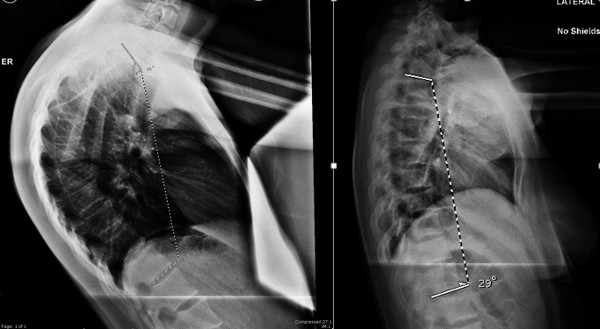Description
The back is normally curved when viewed from the side. The upper back curves outward and the lower back curves inward. In some cases, the spine may be too prominent or rounded. This is abnormal kyphosis.

Patient with Scheuermann’s Kyphosis before (a) and after surgical correction (b). Images courtesy of Pat Cahill, MD, Shriners Hospitals for Children, Philadelphia.
Symptoms
Kyphosis may be noted on a screening exam at school. Someone may notice that the spine looks hunched over or humped. The rounded back may be of cosmetic concern to patients and/or families.
Some patients with kyphosis complain of back pain, however, many patients have no pain. Rarely do kyphosis patients have numbness, tingling, leg weakness, difficulty walking, or incontinence.
Examination
Your child’s doctor will perform a screening examination and evaluate his or her back.
Other Tests
X-rays: If necessary, your doctor may order x-ray to evaluate the spine. Kyphosis of greater than 50 degrees in a child or adolescent is considered abnormal.
CT or MRI: A CT or MRI scan is not commonly needed to evaluate kyphosis. However, in certain cases your doctor may recommend these tests.
Kyphosis Types, Treatment, and Outcomes
Postural Kyphosis
This is an increased but flexible rounding of the spine. It may be due to poor posture. It becomes most noticeable during adolescence. Girls get this more often than boys. It is not usually painful.
Postural kyphosis may be treated with physical therapy or exercise to improve strength and posture. It does not usually cause problems later in life.

Left image shows vertebral wedging of Scheurmann’s Kyphosis. There are 5 – 10 vertebrae that are wedged. Right image shows a spine without kyphosis.
This type of kyphosis is caused by wedge shaped spine bones (vertebrae). It is usually seen in the upper or middle spine. This curve is often bigger than with postural kyphosis. Scheuermann’s kyphosis often appears during adolescence. There may be back pain at the apex of the curve. It is more common in boys than girls.
This may be treated initially with exercises, physical therapy and anti-inflammatory medication to control pain. Sometimes doctors recommend bracing. In severe cases (curves larger than 75 degrees), surgical correction may be considered. Surgery can decrease the rounding of the spine by fusing the abnormal segments into a straighter position.
Congenital Kyphosis
In congenital kyphosis, the spinal column did not form normally before birth. Some vertebrae may be abnormally formed or fused together. This can cause a progressive kyphosis as the child grows.
This type of kyphosis may require periodic check-ups by your doctor. Surgery may be recommended at a young age to correct the position of the spine and prevent progressive deformity. Without treatment, some forms of congenital kyphosis can lead to severe deformity and neurologic problems.
Condition QR Code:


 POSNA.org
POSNA.org


